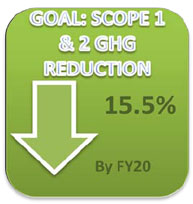U.S. Department of Health & Human Services
Email Updates ![]() Font Size
Font Size 
 Print
Print  Download Reader
Download Reader 
2011 Strategic Sustainability Performance Plan SummaryBack to Sustainability Plan summary page 2011 Strategic Sustainability Performance Plan Summary (PDF - 776KB) U.S. Department of Health and Human Services (HHS) Sustainability and Adaptation Policy Statement Our ImpactAt 83,745 employees HHS is one of the biggest agencies within the U.S. Government. We own 2,980 buildings, and lease another 1,003 for a total square footage of 51,864,431. We operate 1,240 locations throughout the United States and 12 internationally. HHS has a fleet of 795 owned vehicles and 2,930 leased vehicles. Our operating budget for Fiscal Year 2010 was approximately $854,174,000,000 while the amount of money spent on energy consumption for Fiscal Year 2010 totaled $167,500,000. Direct Greenhouse Gas Emissions from sources that are owned or controlled by HHS and resulting from generation of electricity, heat or steam purchased by HHS (Scope 1&2 emissions) totaled 0.96 MMTCO2e. Indirect Greenhouse Gas Emissions from sources not owned or directly controlled by HHS but related to agency activities (Scope 3 emissions) totaled 0.29 MMTCO2e. These statistics show the significant impact that HHS has on the environment, but also the tremendous opportunity that our agency has to make a positive impact. Most importantly, the crucial contribution that HHS makes has to do with our mission. There is a direct connection between Health and Sustainability, and communicating this relationship is where our agency will make its stand. Sustainability and Our Mission
The Department’s mission activities are carried out by a large number of employees in numerous facilities across the U.S. and abroad. The unique character of HHS is reflected in the types of buildings we occupy. Office buildings comprise less than 36% of total gross square footage, with the balance housed in laboratories and hospitals (34% and 8%, respectively), family housing (7%), warehouses (4%), and other buildings (11%). Mission-Related Challenges and Actions Taken to Address Them A detailed review of relationships between general sustainability goals and mission priorities conducted by HHS in 2011 revealed no significant mission related conflicts or challenges. In fact, the review found that many sustainability initiatives supported our public health objectives. Some potential conflicts and challenges became apparent as specific aspects of goal implementation strategies were developed. In most cases these were identified by subject matter experts in the various goal centric working groups of the HHS Sustainability Task Force. These experts recommended courses of action to address them, which may include changes in policies, funding priorities, research and development, and solicitations for innovation projects. Our StandHHS must assume a leadership role in concurrently promoting both sustainability and health throughout the Federal government. Just as the Department of Energy (DOE) leads initiatives relating to energy reduction, HHS leads initiatives relating to health and well-being.
|
| In Fiscal Year 2010, HHS developed a stronger foundation and plan for achieving EO energy reductions and GHG savings under the structure of the HHS Energy Program. The core of the HHS Energy Program and structure is the Energy Management Workgroup. This team has established priorities and actions plans under the direction of the HHS Energy Officer. Focusing on the completion of comprehensive audits, installation of energy meters, automation of data gathering and reporting, and training and outreach, the workgroup has determined key actions to be completed in order to achieve significant energy savings. | The workgroup began many of these actions in Fiscal Year 2010 through the completion of training webinars, offering of major outreach events and monthly toolkits, identification of automated reporting tools and development of policy documents. Additionally, alternative financing contracts and specific projects were completed to advance energy savings. Guidance documents on the completion of audits and commissioning were identified or established as well. It is critical that audits be completed in order to identify the most cost effective efficiency projects. |
 Scope 1&2: Greenhouse Gas Reduction Highlights
Scope 1&2: Greenhouse Gas Reduction Highlights
In Fiscal Year 2010, the energy consumption of HHS facilities was 8,512,821 million British thermal units (MMBtu) over 31.3 million square feet for an energy consumption rate of 272.3 MMBtu per thousand gross square foot (kSF). The total annual energy consumption includes the credit for renewable energy purchases, which is a 21% decrease when compared to the Fiscal Year 2003 baseline of 344.8 MMBtu/kSF. The Fiscal Year 2010 energy consumption rate for HHS facilities was 4.4% less than the Fiscal Year 2009 usage.
The availability of ARRA funds in Fiscal Year 2010 allowed the Indian Health Service (IHS) Aberdeen Area to fund multiple projects that will improve building system efficiencies (power and water) and employ renewable energy technologies resulting in system reliability that is expected in modern health care facilities. Several HVAC systems in the Area are currently being modernized with new control system components that will replace aged and poorly performing pneumatic systems with modern Direct Digital Control (DDC) systems. Testing, adjusting, and balancing ventilation systems that were funded with ARRA dollars will ensure that system performance is optimized and establish new benchmarks of performance at existing facilities with HVAC systems that were constructed several years ago.
 In addition, ARRA funding has been used to develop two renewable energy projects (Rosebud and Pine Ridge) in the IHS Aberdeen area. These projects are in the construction phase and include 50 kW wind generators and a 10 kW photovoltaic (PV ) solar cell array at each of the service units. This renewable energy source will be used to reduce the energy purchased from the local electrical utility, reducing utility "demand" charges and saving power consumption charges. These projects are on Native American lands leased to IHS and all energy produced by the wind and PV systems will be consumed at the facilities where the energy is produced.
In addition, ARRA funding has been used to develop two renewable energy projects (Rosebud and Pine Ridge) in the IHS Aberdeen area. These projects are in the construction phase and include 50 kW wind generators and a 10 kW photovoltaic (PV ) solar cell array at each of the service units. This renewable energy source will be used to reduce the energy purchased from the local electrical utility, reducing utility "demand" charges and saving power consumption charges. These projects are on Native American lands leased to IHS and all energy produced by the wind and PV systems will be consumed at the facilities where the energy is produced.
The NIH Bethesda Campus had two Utility Energy Service Contracts (UESC) implemented in Fiscal Year 2010. One is an initial phase of retro-commissioning3 ; the other is the second phase of a building controls project. The NIH Frederick campus developed a new Energy Service Performance Contract (ESPC) to replace the previous Basic Ordering Agreement (similar to a UESC) with Constellation Energy/Allegheny Power, which expired right after a major steam plant construction project was consummated. This ESPC will enable the implementation of further efficiency projects and is expected to be signed in Fiscal Year 2011.
The IHS Blackfeet Service Unit received a high Energy Star Portfolio Manager score of 84. This score resulted in the unit being awarded an Energy Star award. This award is rare for a facility that is 24 years old and for a hospital that is open 24 hours a day and 7 days a week.
_________________________________
3 Retro-commissioning (RCx) is a systematic, documented process that identifies low-cost operational and maintenance improvements in existing buildings and brings the buildings up to the design intentions of its current usage.
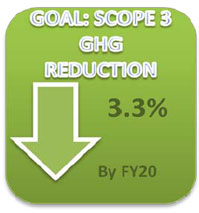 Scope 3: Greenhouse Gas Reduction
Scope 3: Greenhouse Gas Reduction
In the Fiscal Year 2010, HHS set a reduction target of 3.3% of Scope 3 (indirect emission sources) by Fiscal Year 2020. The following were Fiscal Year 2020 reduction targets for the subcategories of Scope 3 sources:
- 7.5% for transmission and distribution (T&D) losses from purchased electricity
- 1% for federal employee travel
- 14.5% for contract waste and wastewater treatment
| HHS reduced emissions in business ground travel despite a significant growth in employee population. This reduction could be attributed to an increase in the use of web-based collaboration tools and teleconferencing. HHS will continue to offer programs and initiatives that will reduce scope 3 emissions and promote healthy lifestyles. These programs range from offering transit subsidies to flexible work schedules and places. Participation in these programs, primarily telework, has remained steady. | A commuter survey was implemented and shared with the HHS Office of Human Resources to implement behavioral change strategies aimed at increasing use of flexible schedules/places, particularly telework. The increased use of telework is a key strategy in reducing scope 3 emissions. Lastly, many offices within HHS have recycling and energy efficiency programs that conserve resources and reduce the overall consumption of materials. For example the Program Support Center (PSC) and NIH recycle nearly 48% and 30% of waste, respectively. |
Scope 3: Greenhouse Gas Reduction Highlights
The challenge for HHS will be setting appropriate GHG reduction targets for each OPDIV. These targets will have to balance mission requirements while encouraging a change in business/management culture during a time of mission expansion. To highlight one such challenge, the larger OPDIVs (CDC, FDA, IHS, and NIH) comprise approximately two-thirds of federal employee population. Because many of the personnel in these OPDIVs perform patient care and laboratory tasks that must be performed at HHS facilities, it is highly likely that a considerable number of employees may not be eligible for recurring telework. Some OPDIVs are increasing personnel making reductions in total emissions more difficult to obtain.
High Performance Green Buildings/Regional Planning
The largest environmental impacts from HHS mission activities are associated with siting, construction and operation of building assets. To help mitigate these impacts, HHS has incorporated the high-performance sustainable design requirements of the federal “Guiding Principles for High Performance and Sustainable Buildings” (GPs) in the HHS Facilities Program Manual. The first HHS Policy for Sustainable and High Performance Buildings was issued in September 2006 and incorporated into the HHS “Sustainable Buildings Implementation Plan (SBIP).” The SBIP was updated in April 2011 as the “Sustainable Buildings Plan” (SBP), to incorporate Executive Order 13514 requirements.
Attainment of the goals and targets in the SBP will significantly reduce energy, water and materials use, and GHG emissions and waste generation, consistent with the goals of this plan. Additionally, HHS is developing science-based indoor environmental quality (IEQ) criteria that will improve the health performance of buildings and supplement the current GPs and LEED®4 requirements. Each sub-goal below includes a description of current SBP targets and/or focus, along with gaps the Department intends to address in the next year.
HHS semi-annually captures and reports performance in implementation of the GPs into its inventory through update of the OMB Environmental Scorecard, which is available on the OMB website. Progress is updated annually in the SSPP and SBP. The baseline inventory is evaluated annually to capture the most current data.
HHS is an advocate for smart design and construction of buildings to create healthy and productive work environments for Federal tenants, patients and visitors in our owned and leased facilities.
High Performance Green Building/Regional Planning Highlights
Overall, HHS is making operations more efficient and prioritizing facilities investments that will result in long term conservation of energy, water and other resources. We are consolidating our operations in modern, more efficient buildings, and where possible, removing inefficient assets from our inventory. The Department is also striving to improve the health of those who work in, visit, and occupy our facilities by connecting design and operational decisions to positive health outcomes.
 One example is the Healthy Community Design Initiative within the CDC’s National Center for Environmental Health, which is dedicated to understanding and improving the relationship between community design and public health. Currently, work is being done to identify partners for a cooperative agreement that will increase the knowledge and capacity for Health Impact Assessments (HIA). HIA helps decision-makers avoid adverse health consequences and costs, and improve health. HIA may also reduce environmental injustices by characterizing opportunities to improve the relationship between affected vulnerable groups and the policy or project.
One example is the Healthy Community Design Initiative within the CDC’s National Center for Environmental Health, which is dedicated to understanding and improving the relationship between community design and public health. Currently, work is being done to identify partners for a cooperative agreement that will increase the knowledge and capacity for Health Impact Assessments (HIA). HIA helps decision-makers avoid adverse health consequences and costs, and improve health. HIA may also reduce environmental injustices by characterizing opportunities to improve the relationship between affected vulnerable groups and the policy or project.
Finally, checklists developed for use in the HHS “Sustainable Buildings Plan” have been adopted for use by other federal agencies, including the U.S. Department of Agriculture. They include: Sustainable Buildings Checklist for Projects , Sustainable Buildings Checklist for Lease Actions, Letter of non-Conformance, and Existing Buildings Assessment Tool.
_____________________________
4 Leadership in Energy and Environmental Design.
Water Use Efficiency
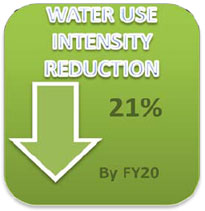 HHS has revised the potable water reduction targets to a water use intensity reduction of 21% by Fiscal Year 2020 as compared to the Fiscal Year 2007 baseline year, which is still less than the EO 13514 goal of 26%. Water use trends of each OPDIV were analyzed and new goals were established. In Fiscal Year 2012 and 2013, significant water reductions are expected due to the implementation of a project at the NIH Bethesda Campus in Bethesda, MD. From Fiscal Year 2013 to Fiscal Year 2020, each OPDIV is estimated to reduce water use intensity by 2% per year through additional water efficiency projects and the implementation of leak detection programs starting in Fiscal Year 2014. However, changes in scientific mission and laboratory operations could increase water use intensity and impact the Department’s ability to meet the forecasted future water use intensity reduction goals.
HHS has revised the potable water reduction targets to a water use intensity reduction of 21% by Fiscal Year 2020 as compared to the Fiscal Year 2007 baseline year, which is still less than the EO 13514 goal of 26%. Water use trends of each OPDIV were analyzed and new goals were established. In Fiscal Year 2012 and 2013, significant water reductions are expected due to the implementation of a project at the NIH Bethesda Campus in Bethesda, MD. From Fiscal Year 2013 to Fiscal Year 2020, each OPDIV is estimated to reduce water use intensity by 2% per year through additional water efficiency projects and the implementation of leak detection programs starting in Fiscal Year 2014. However, changes in scientific mission and laboratory operations could increase water use intensity and impact the Department’s ability to meet the forecasted future water use intensity reduction goals.
HHS will continue with water efficiency training to assist water personnel with the identifying and implementation of water use technologies. One class was held for the OPDIV water managers in December 2010 in which water reuse applications were covered. Additional training for environmental engineers and landscaping engineers needs to be conducted to improve water intensity usage in ILA consumption.
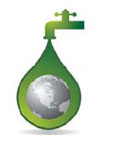 The current HHS Sustainable Building Plan (SBP) requires compliance with EISA 2007 and is proactive in addressing stormwater management as a compliance requirement under the Guiding Principles.
The current HHS Sustainable Building Plan (SBP) requires compliance with EISA 2007 and is proactive in addressing stormwater management as a compliance requirement under the Guiding Principles.
HHS has incorporated appropriate reduction strategies for non-potable water use into the HHS SBP where it addresses landscaping and irrigation strategies, as well as the employment of design and construction strategies that reduce stormwater runoff and polluted site water runoff.
 In Fiscal Year 2010, HHS developed a stronger foundation and plan for achieving EO water reductions and SSPP savings under the structure of the HHS Water Program. The core of the HHS Water Program and structure is the Water Management Workgroup. This team has established priorities and action plans under the direction of the HHS Energy Officer. Focusing on the completion of comprehensive audits, installation of energy and water meters, automation of data gathering and reporting, training, and outreach, the workgroup has determined key actions to be completed in order to achieve significant savings.
In Fiscal Year 2010, HHS developed a stronger foundation and plan for achieving EO water reductions and SSPP savings under the structure of the HHS Water Program. The core of the HHS Water Program and structure is the Water Management Workgroup. This team has established priorities and action plans under the direction of the HHS Energy Officer. Focusing on the completion of comprehensive audits, installation of energy and water meters, automation of data gathering and reporting, training, and outreach, the workgroup has determined key actions to be completed in order to achieve significant savings.
The workgroup began many of these actions in Fiscal Year 2010 through the completion training webinars and classroom hours focusing on water reduction and reuse strategies as well as water auditing procedures. The completion of water audits has been identified as a priority not only to meet EISA auditing requirements, but to identify cost effective water efficiency projects. Additional training on the performance of comprehensive auditing is planned for August 2011 and two more additional dates in Fiscal Year 2012 in order to train HHS energy personnel to perform in-house audits. Once the audits have been completed, specific projects can be planned for implementation. Implementation of projects will fall primarily under alternative financing projects, as it has been in Fiscal Year 2010 and previous years.
OPDIV water metering plans will be updated and the installation of meters will continue in Fiscal Year 2011 and 2012. In addition, the first submission of the leak detection milestones per the new HHS policy will be submitted by the OPDIV in Fiscal Year 2011. These milestones will outline the procedure that the OPDIV will take to implement leak detection programs in their facilities. Leak detection and repair programs are required to be implemented by Fiscal Year 2014 and should provide significant water reductions throughout the Department.
The automated water use data gathering and reporting tools that have been identified will be populated with facility information and specific details. Fiscal Year 2011 will be the year that the tools are set-up and refined, so that in Fiscal Year 2012 more time can be focused on the implementation of projects.
Outreach has become a focus in Fiscal Year 2011 and will continue to gain importance in future years. Educating all employees on the goals and initiatives will maximize savings and efficiency. Through outreach, HHS will aim to change employee habits on use of water and foster new ideas on conservation.
Water Use Efficiency Highlights
As a result of the HHS SSPP, a water management workgroup was formed to coordinate efficiency efforts throughout the Department. The workgroup consists of the water managers of each HHS OPDIV, and the key support personnel.
HHS headquarters coordinated a water efficiency training course in December 2010 for the water managers and technical personnel throughout the HHS OPDIV.
PSC held the Department’s first World Water Day on March 22 to raise employee awareness on water efficiency.
The FDA Irvine Laboratory has a grey water capture and reuse system.
Pollution Prevention
In support of Pollution Prevention and Waste Reduction (P2WR), HHS will focus on the following top 3 activities over the upcoming 12 months:
- Improve data tracking for solid waste diversion consistent with SSPP P2WE goals.
- Implement the HHS mercury reduction policy and continue to develop strategies to identify and reduce use of
toxic materials. Increase diversion of compostable items from the waste stream.
 HHS will also:
HHS will also:
- Increase source reduction of pollutants and waste.
- Divert at least 50% of non-hazardous solid waste by 2015
- Develop agency strategies to reduce municipal solid waste sent to landfills and evaluate how their implementation will assist the agency in achieving 2020 GHG reduction targets.
- Divert at least 50% of Construction and Demolition (C&D) materials and debris by Fiscal Year 2015
- Reduce printing paper use
- Increase use of uncoated printing and writing paper containing at least 30% post-consumer fiber.
- Reduce and minimize the acquisition, use, and disposal of hazardous chemicals and materials.
- Increase diversion of compostable organic materials from the waste stream
- Implement integrated pest management and landscape management practices to reduce and eliminate the use of toxic and hazardous chemicals and materials.
- Increase use of acceptable alternative chemicals and processes.
 Hazardous/Regulated Waste:
Hazardous/Regulated Waste:
HHS dedicates considerable resources to safe and responsible management of hazardous and radioactive wastes. Management of these wastes is costly and the inherent higher risks associated with these materials requires priority allocation of limited resources over non-hazardous wastes. Figure 1 shows the various quantities of regulated waste generated by HHS in metric tons (MT):
- 2,160 MT Medical waste:
- 364 MT Hazardous waste
- 47 MT Radioactive and mixed waste
These categories are generated at 18 facilities that are categorized by the Environmental Protection Agency (EPA) as large quantity generators; 26 facilities are categorized as small-quantity generators and 33 facilities categorized as conditionally exempt small quantity generators of hazardous wastes.
 Non-Hazardous Solid Waste:
Non-Hazardous Solid Waste:
Recycling programs were reported at approximately 90% of the facilities and 21% of the facilities reported active composting programs. Non-C&D recycling rates (not including composting) varied from 4% to 47% with the overall average of approximately 17%. The total quantity of solid waste to landfill (used for Scope 3 greenhouse gas emission Figure 2 shows the non-C&D solid waste disposal by destination.
Solid waste data provided here is still preliminary in nature and will be refined as data collection systems are improved.
Waste to Energy:
Over 13,000 tons (28%) of solid waste was diverted from landfill to waste to energy. This is the primary disposal method used by the major HHS facilities in the Greater Washington DC Metropolitan Area.

Composting:
In 2010 HHS identified 24 facilities with on-site composting but no estimates for quantity or volume. NIH Bethesda is seeking a commercial composting facility and conducted a site visit to a recently opened facility in Carroll County, MD. If viable and funds permit, the NIH Bethesda facilities plan to divert cafeteria waste for composting in late 2011. The NIH Research Triangle Park (RTP) in NC initiated composting of all cafeteria food waste and the Office of the Secretary (OS) at the Hubert H. Humphrey Building (HHH) completed a review of sites and environmental requirements for compost sites and developed a Request for Proposal (RFP) for collection and composting of cafeteria waste. New recycling and compost collection bins are on order and promotional plans are under development. Compost plans are anticipated to be finalized in late 2011 and will culminate a multi-year cafeteria greening effort that incorporates healthy menu choices and reusable and compostable containers.
Pollution Prevention Highlights
FDA initiated several actions to improve its recycling program at the White Oak Campus, which resulted in an increase from 30 tons of material recycled in Fiscal Year 2009 to 111 tons in Fiscal Year 2010. This equates to an increase of 27 pounds of recycled materials per person from Fiscal Year 2009 to Fiscal Year 2010 and data will be reported on the follow up waste assessment when requested by headquarters after 2011.
FDA’s Office of White Oak Services (OWOS) collaborated with GSA to green the cafeteria services and housekeeping services contracts. Contractors performed assessments of all cooking, cleaning, servware and housekkeeping products and replaced them with green, biodegrable substitutes and/or “Green seal” products.
IHS developed “Chapter 13: Environmental Compliance, Stewardship, and Sustainability” of the IHS Health Manual which incorporates aspects of Executive Order 13514 and the HHS Strategic Sustainability Performance Plan (SSPP) which is expected to become official policy in Fiscal Year 2011. It also developed the Sustainability Advisory Board (SAB) Charter. The SAB, which includes all IHS staff involved in HHS sustainability workgroup and their respective office directors, will support the IHS Chief Sustainability Officer (CSO).
NIH updated lists and tracking of NIH Priority Chemicals through the EMS and used Green Teams and Sustainable Lab Groups to promote hazardous chemical reductions, the use of MIT web based Green Chemicals Alternative Purchasing Wizard and less toxic lab products at two 2010 Green Fairs.
Program Support Center (PSC) at the Parklawn Building was awarded the 2010 Business Outstanding Achievement in Recycling Award by Montgomery County Maryland. It increased its solid waste diversion rate for calendar year 2010 from 46% to 48% for the Parklawn building.
Hubert H. Humphrey building inaugurated a ‘green’ cafeteria with healthier menu choices and all biodegrable food service items. It also began to upgrade its recycling program, beginning with reinitiating cardboard recycling and replacing 2000 desktop containers (for mixed paper). New signage and central recycling containers are in the works for later FY 2010.
Sustainable Acquisitions
HHS will ensure that 95% of new contract actions, including task and delivery orders under new contracts will incorporate sustainable acquisition requirements. These include requirements for the supply or use of products and services that are energy efficient (Energy Star or Federal Energy Management Program (FEMP)-designated), water efficient, biobased, environmentally preferable (excluding EPEAT-registered products), non-ozone depleting, contain recycled content, and non-toxic or less toxic materials.
HHS will update agency affirmative procurement plans (also known as green purchasing plans or environmentally preferable purchasing plans), policies, and programs to ensure that all mandated federally designated products and services are included in all relevant acquisitions.
Implementation of the HHS Sustainable Acquisition policy will facilitate the systematic collection of green purchasing data and lessen the OPDIV/STAFFDIV administrative burden as it relates to measurement of the 95% sustainability metric and meeting the sustainable acquisition threshold for HHS Agency Sustainability Plans and Federal Environmental Scorecards, e.g., the OMB Sustainability Scorecard. Assessment and Monitoring - HHS has incorporated an environmental component into its Procurement Management Reviews (PMRs) that assesses the strengths, weaknesses, and best practices of the acquisition function. PMRs will now address compliance | with the 95% green purchasing requirement and the effectiveness of each OPDIV sustainable procurement program. In Fiscal Year 2011, HHS will conduct 3 PMRs at the following OPDIV: CMS, IHS, and CDC. In Fiscal Year 2012, HHS will also conduct PMRs at 3 additional OPDIV. HHS has also added a sustainable acquisition performance metric to the HHS Acquisition Dashboard, which measures OPDIV performance across a spectrum of acquisition related areas. The performance indicator “95% percent of all applicable sustainable acquisitions” will be measured on a quarterly basis beginning 3rd quarter Fiscal Year 2011. |
Sustainable Acquisitions Highlights
As part of its long term objective of strengthening the FDA base of operations, the Office of Information Management (OIM) set a goal of increasing the percentage of high efficiency servers from 25% to 50% in Fiscal Year 2010. As of April, 2011, 98% of FDA servers are high-efficiency-energy star compliant. The FDA Office of Acquisition and Grants Services’ (OAGS) IT Division supported OIM’s objectives with a series of strategic contracts and orders for servers, related equipment and software totaling $9.3 million. Many of these purchases allowed OIM to replace older, less efficient machines with equipment that met or exceeded current Energy Star standards. OAGS ensured that all of these acquisitions contained appropriate green purchasing clauses and made “compliance with all green standards” an element in the overall source selection decision by using a low-price-technically-acceptable evaluation scheme.
The CDC Procurement and Grants Office (PGO) published its Green Procurement Policy in July 2010. This policy was developed to respond to laws and regulations requiring a comprehensive CDC-wide plan to acquire products that have recycled and biobased material content and that are energy efficient, whenever they are cost effective and meet technical requirements.
OGAPA held a symposium in April 2011 focused on educating and enriching stakeholder and customer knowledge in the acquisition, grants, and small business areas. The symposium included green presentations on understanding sustainable acquisitions and bio-preferred purchasing given by federal subject matter experts.
Each OPDIV Head of Contract Activity (HCA), in concert with their respective Green Procurement Managers, determined the number of applicable contract actions including: Blanket Purchase Agreements (BPAs); solicitations for new contracts modifications to existing contracts; to add green product requirements; task orders under existing multi-year contracts; indefinite delivery indefinite quantity (IDIQ); multiple award contracts; multiple award schedules and requirements contracts) by selecting actions for which green products could be supplied or used. Once the applicable contract actions were selected, a sample of at least 5% of those contracts were manually reviewed to determine whether they included requirements for green products and/or services for which green products could be used.
Electronic Stewardship
 HHS has surpassed its goal of ensuring that 95% of agency electronic products purchased are EPEAT-registered5 . As a department, HHS currently ensures 97% of its computers are Energy Star qualified and is establishing an Electronic Stewardship Policy to extend the useful life of agency electronic equipment.
HHS has surpassed its goal of ensuring that 95% of agency electronic products purchased are EPEAT-registered5 . As a department, HHS currently ensures 97% of its computers are Energy Star qualified and is establishing an Electronic Stewardship Policy to extend the useful life of agency electronic equipment.
HHS is currently documenting the compliance with FEMP-designated products. However, with the majority of acquisitions being EPEAT-registered or ENERGY STAR qualified, the majority of acquisitions will also be FEMP-designated.
HHS is establishing an Electronic Stewardship Policy to track and enable power management, duplex printing, and other energy-efficient or environmentally preferable features on all eligible agency electronic products. It will also reflect environmentally sound practices of disposing all agency excess or surplus electronic products.
The majority of HHS already disposes of electronic assets using sound disposition practices. For the most part, HHS already disposes of electronic assets using either Unicor donation or through a private recycler certified under the Responsible Recyclers (R2) guidance or equivalent certification. The remaining electronic assets are difficult to dispose due to the remote locations of our facilities and inaccessibility to the proper disposing resources. Currently, if an OPDIV cannot dispose of electronic assets themselves, they will dispose through ITIO6. For the remote locations, HHS is determining how to dispose of these electronic assets appropriately and cost-effectively.
The elements of the Electronic Stewardship Plan and the Electronic Stewardship Implementation Plan (May 2007) are being incorporated into the Electronic Stewardship Policy.
Currently, HHS has enabled power management on 72% of eligible PCs. To meet the deadline of 06/30/2011 in meeting the 100% Power Management goal, HHS is implementing numerous solutions across the OPDIVs. All OPDIVs across HHS have committed to meeting the June 30 deadline for implementing power management on 100% of eligible devices.
HHS recycles nearly 90% of its electronic devices and/or products disposed of using environmentally sound practices. Each member OPDIV is working to find vendors capable of utilizing sound practices to dispose of electronic devices/products.
 Power Reduction Settings that interfere with the intended purpose and use of an individual electronic device may be disabled on a case-by-case basis as required to ensure proper functionality by support organizations, staff delegated with that authority by the OPDIV, or HHS Office of the Chief Information Officer (OCIO).
Power Reduction Settings that interfere with the intended purpose and use of an individual electronic device may be disabled on a case-by-case basis as required to ensure proper functionality by support organizations, staff delegated with that authority by the OPDIV, or HHS Office of the Chief Information Officer (OCIO).
HHS has developed a data center management policy to enable achievement of the HHS consolidation goals in OMB’s Data Center Consolidation Initiative (DCCI) and to satisfy environmental and energy directives and requirements associated with HHS data centers. The policy sets standards and thresholds for sever and rack utilization, server virtualization, data center temperature, green procurement, etc. The policy was ratified on March 22, 2011. We are working with HHS data center managers to ensure all data centers comply with the policy.
2011 Goals:
HHS developed two policies, one for Electronic Stewardship and another for the management of Data Centers. The purpose of the ES policy is to provide the framework for the implementation of sound environmental practices in the acquisition, operations and maintenance, and end-of-life management of HHS-purchased electronic products. The purpose of the Policy for Data Center Management (March 22, 2010) is to establish a course of action and define responsibilities for operating data centers efficiently throughout HHS. The primary focus is to enable achievement of the consolidation goals in OMB’s Data Center Consolidation Initiative (DCCI) and to satisfy environmental and energy directives and requirements associated with HHS data centers as provided in Executive Orders 13423 and 13514. The establishment of these practices: a) will enhance and expand existing HHS sustainable practices in order to comply with Executive Order (E.O.) 13423 and 13514, b) may reduce energy consumption, c) may reduce toxics disposal related to electronics, and d) may save money through reduced energy consumption and increased electronics life expectancy. In all aspects of its acquisitions and operations, HHS aspires to be a good steward of the earth’s resources and a wise manager of the taxpayer’s dollar.
These policies incorporate the Electronic Stewardship Plan (May 2007) and Electronic Stewardship Implementation Plan. The Electronic Stewardship policy will be finalized in Fiscal Year 2011 and the Policy for Data Center Management was finalized in March 2011. In addition to the above, the intent of the policies is to:
- Set precedence and standard for collecting information to determine if HHS is on course in complying with the mandate;
- Facilitate compliance and highlight when HHS has veered off course; and
- Require operating divisions to participate in the Federal Electronics Challenge.
The OMB data center definition has changed significantly since our plan was delivered to OMB in August of 2010. The current OMB data center definition requires a data center to be at least 500 sq. ft. in area. HHS has 45 data centers that meet the new definition. Our plan is to close 10 of them by the end of 2013. Two have been closed already this year. One of which was closed through a cross servicing opportunity with the Department of Interior. This cross servicing opportunity enabled the operations of an HHS data center in Albuquerque, NM to move to a Department of Interior data center in the same city. Two additional HHS data centers are scheduled to be closed this year and the remaining six will be closed in 2012 and 2013.
HHS has 131 data centers that do not meet the 500+ sq. ft. threshold set by OMB. We are tracking those internally and plan to close 46 of them by the end of 2013.
Electronic Stewardship Highlights
HHS established a Department-level Electronic Stewardship Workgroup (ESWG) to discuss progress towards meeting the ES Goals, share lessons learned and best practices on ES activities, and contribute towards workgroup deliverables, such as policy, SSPP, etc. The ESWG contributed to the development of the ES Policy, assisted in the development of reporting mechanism to capture progress towards meeting the sub-goals, contributed to revising the SSPP, and mandated enrollment in the Federal Electronics Challenge.
HHS consolidated legacy mainframe workloads and began server virtualization to reduce the number of physical servers.
HHS added contract language and engaged procurement officers to only purchase green office supplies as well as EPEAT and Energy Star compliant devices.
HHS enabled duplex printing on new and legacy printers, and instituted printing best practices including default black and white printing, toner and print cartridge returns, and no personal desktop printers without justification.
HHS instituted green best practices for the office including minimal use of personal fans, heaters and refrigerators, and lighting controls to ensure lights turn off after 30 minutes.
HHS created an Aggressive Power Management campaign to meet mandate of being Power Management (PM) enabled on 100% of eligible devices.
________________________________
5 Electronic Product Environmental Assessment Tool.
6 Information Technology Infrastructure and Operations.
Agency Innovation
 Most of the relatively short term goals of current directives and this plan focus on only making HHS operations more sustainable (reduced use of resources and no net degradation of the environment). In the longer term, attainment of such goals may not ensure the availability of sufficient resources and prevent the public health impacts of scarcity, pollution and climate change. Global trends of rapid population growth and increasing per capita consumption will concomitantly increase environmental impacts and accelerate resource depletion. To adapt, a fundamental shift from our current goals to more comprehensive sustainability goals will be required:
Most of the relatively short term goals of current directives and this plan focus on only making HHS operations more sustainable (reduced use of resources and no net degradation of the environment). In the longer term, attainment of such goals may not ensure the availability of sufficient resources and prevent the public health impacts of scarcity, pollution and climate change. Global trends of rapid population growth and increasing per capita consumption will concomitantly increase environmental impacts and accelerate resource depletion. To adapt, a fundamental shift from our current goals to more comprehensive sustainability goals will be required:
– Energy neutral buildings →Energy positive buildings
– Greenhouse gas reduction → Carbon negativity, sequestration
– Health protective indoor environments → Health improving indoor environments
– Water conservation →Total water reuse
– Waste reduction and recycling → Zero waste, material renovation to higher uses
HHS recognizes that progress on meeting its current sustainability goals and these longer range objectives of environmental enhancement will require aggressive pursuit of innovations– strategies that have not been previously implemented by others across the Government. These will range from adaptations and new applications of existing innovations from other fields to the development of new technologies requiring large investments and extensive research and development efforts.
 Sustainability is integral to the HHS mission, which is to protect the health of all Americans and provide essential human services, especially to those who are least able to help themselves. Sustainability has been defined as “the enduring prosperity of all living things.” By this measure, sustainability is directly linked to the health of humans, the health of the environment, and the health of economic systems that support and promote our well-being. This triple health bottom line – human health, environmental health and economic health– is integral to HHS’s mission and the sustainability mandates of Executive Order (EO) 13514.
Sustainability is integral to the HHS mission, which is to protect the health of all Americans and provide essential human services, especially to those who are least able to help themselves. Sustainability has been defined as “the enduring prosperity of all living things.” By this measure, sustainability is directly linked to the health of humans, the health of the environment, and the health of economic systems that support and promote our well-being. This triple health bottom line – human health, environmental health and economic health– is integral to HHS’s mission and the sustainability mandates of Executive Order (EO) 13514.
 HHS faces a special challenge in improving the performance of its laboratories because laboratory operation consumes far more energy and other resources than commercial office buildings. Nevertheless, great progress is being made. At CDC’s Ft. Collins, CO, Building 401, a new laboratory and support space for CDC’s Office of Infectious Disease uses 15.84% less energy for lighting and 43.87% less water than a standard laboratory. This project received a LEED® Gold for Commercial Interiors rating.
HHS faces a special challenge in improving the performance of its laboratories because laboratory operation consumes far more energy and other resources than commercial office buildings. Nevertheless, great progress is being made. At CDC’s Ft. Collins, CO, Building 401, a new laboratory and support space for CDC’s Office of Infectious Disease uses 15.84% less energy for lighting and 43.87% less water than a standard laboratory. This project received a LEED® Gold for Commercial Interiors rating.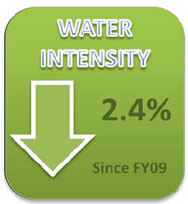 In Fiscal Year 2010, HHS reduced water intensity by 2.4% as compared to Fiscal Year 2009, and is currently at the Fiscal Year 2007 baseline consumption. Several water efficiency projects were completed in Fiscal Year 2010 such as cooling tower upgrades, well water use, highly efficient plumbing fixtures, and xeriscape landscaping.
In Fiscal Year 2010, HHS reduced water intensity by 2.4% as compared to Fiscal Year 2009, and is currently at the Fiscal Year 2007 baseline consumption. Several water efficiency projects were completed in Fiscal Year 2010 such as cooling tower upgrades, well water use, highly efficient plumbing fixtures, and xeriscape landscaping.